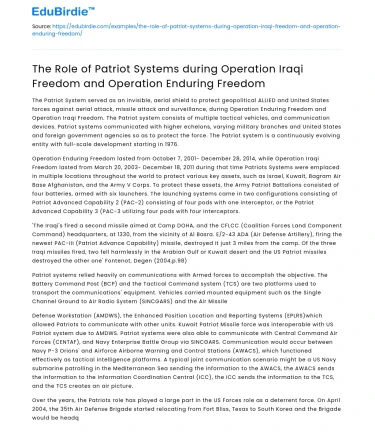The Patriot System served as an invisible, aerial shield to protect geopolitical ALLIED and United States forces against aerial attack, missile attack and surveillance, during Operation Enduring Freedom and Operation Iraqi Freedom. The Patriot system consists of multiple tactical vehicles, and communication devices. Patriot systems communicated with higher echelons, varying military branches and United States and foreign government agencies so as to protect the force. The Patriot system is a continuously evolving entity with full-scale development starting in 1976.
Operation Enduring Freedom lasted from October 7, 2001- December 28, 2014, while Operation Iraqi Freedom lasted from March 20, 2003- December 18, 2011 during that time Patriots Systems were emplaced in multiple locations throughout the world to protect various key assets, such as Israel, Kuwait, Bagram Air Base Afghanistan, and the Army V Corps. To protect these assets, the Army Patriot Battalions consisted of four batteries, armed with six launchers. The launching systems came in two configurations consisting of Patriot Advanced Capability 2 (PAC-2) consisting of four pods with one interceptor, or the Patriot Advanced Capability 3 (PAC-3 utilizing four pods with four interceptors.
Save your time!
We can take care of your essay
- Proper editing and formatting
- Free revision, title page, and bibliography
- Flexible prices and money-back guarantee
'The Iraqi's fired a second missile aimed at Camp DOHA, and the CFLCC (Coalition Forces Land Component Command) headquarters, at 1330, from the vicinity of Al Basra. E/2-43 ADA (Air Defense Artillery), firing the newest PAC-III (Patriot Advance Capability) missile, destroyed it just 3 miles from the camp. Of the three Iraqi missiles fired, two fell harmlessly in the Arabian Gulf or Kuwait desert and the US Patriot missiles destroyed the other one' Fontenot, Degen (2004,p.98)
Patriot systems relied heavily on communications with Armed forces to accomplish the objective. The Battery Command Post (BCP) and the Tactical Command system (TCS) are two platforms used to transport the communications' equipment. Vehicles carried mounted equipment such as the Single Channel Ground to Air Radio System (SINCGARS) and the Air Missile
Defense Workstation (AMDWS), the Enhanced Position Location and Reporting Systems (EPLRS)which allowed Patriots to communicate with other units. Kuwait Patriot Missile force was interoperable with US Patriot system due to AMDWS. Patriot systems were also able to communicate with Central Command Air Forces (CENTAF), and Navy Enterprise Battle Group via SINCGARS. Communication would occur between Navy P-3 Orions' and Airforce Airborne Warning and Control Stations (AWACS), which functioned effectively as tactical intelligence platforms. A typical joint communication scenario might be a US Navy submarine patrolling in the Mediterranean Sea sending the information to the AWACS, the AWACS sends the information to the Information Coordination Central (ICC), the ICC sends the information to the TCS, and the TCS creates an air picture.
Over the years, the Patriots role has played a large part in the US Forces role as a deterrent force. On April 2004, the 35th Air Defense Brigade started relocating from Fort Bliss, Texas to South Korea and the Brigade would be headquartered at Osan Air Force Base, two of the units' missile batteries would be stationed at Kwanju Airbase. The Patriot recapitalization program focuses on operational capability by bringing existing Patriot assets to a 'like-new' (zero-miles/zero-hours) state.
The Patriot system has played a vital role in the War on terrorism through protection, enhanced communication, and tactical advantage over enemy forces. The evolution of enemy forces brings the continuous modernization of Patriots. The Patriots will always be the first to fire both night and day, the secret shield protecting the force.






 Stuck on your essay?
Stuck on your essay?

